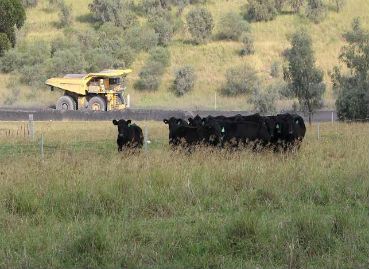
Grazing study shows positive results for rehabilitated mine land
9 Jun 2017

The Department of Primary Industries’ (DPI) three and half year study of beef grazing on rehabilitated mine pastures has confirmed growth of improved pastures provides increased livestock productivity compared to original native pastures.
DPI Technical Specialist Pasture Production, Neil Griffiths said the Hunter mine grazing trial was initiated by the Upper Hunter Mining Dialogue to answer the question - can rehabilitated mine land sustainably support productive and profitable livestock grazing?
“The study has produced valuable insights into beef growth rates while grazing on rehabilitated and analogue summer pastures at two mine sites,” Mr Griffiths said.
“Comparisons of animal and soil health, pasture production and composition and economic outcomes have been measured during the study.
“Ten Angus steers were located at each trial site, with the first group assigned in 2014 and the second group in 2016.
“Results showed that both groups of steers on rehabilitated mine land gained more weight than those on the analogue native pastures at both sites.
“The greater available pasture biomass on the rehabilitated pasture can largely explain the weight gain advantage of the steers on these pastures.
“The final results for the second group showed the steers on the rehabilitated site had an average weight of 529kg/head and 6.2mm fat, while on the analogue site the steers weighed 456kg/head and 3.6mm fat.
“This was consistent with the first group, where steers grazing the rehabilitated mine land were on average 101kg/head heavier, and worth $386/head more than their mates grazing the nearby native pasture which was similar to original pasture on the mine sites.”
Mr Griffiths said the sites had not been mined for 15 and 30 years, and it was interesting to see that there was a lot more diversity in grass species detected than what was initially expected, with over 87 pasture species found at one rehabilitated site.
“The major pasture species sown at the rehabilitated sites included Rhodes grass and Green Panic, while the native pastures of Red grass, QLD Blue grass, Wiregrass and Parramatta grass were present at the analogue sites,” Mr Griffiths said.
“Legumes were sown into the rehabilitated sites and throughout the study no fertiliser had been applied to any of the sites.
“Throughout the study regular soil, pasture and animal blood tests were conducted to check for the presence of heavy metal trace elements. Results have shown no major issues regarding heavy metals.
“Outcomes from this study will assist the mining industry to identify targets for rehabilitation and perhaps changes to rehabilitation practices for successful rehabilitation to grazing land in the region.”
The Hunter mine grazing study is undertaken by NSW DPI with funding support from the mining industry The Australian Coal Industry’s Research Program (ACARP) and NSW Department of Planning & Environment Resources & Energy, Upper Hunter Mining Dialogue, Hunter Local Land Services and local cattle producers.
Media contact: Anne Brook (02) 6763 1163 or 0477 358 305

